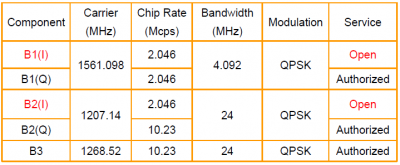If you wish to contribute or participate in the discussions about articles you are invited to contact the Editor
BeiDou Performances: Difference between revisions
No edit summary |
No edit summary |
||
| Line 12: | Line 12: | ||
==COMPASS Performances== | ==COMPASS Performances== | ||
The BeiDou-1 system was established in 2003 for the area of the greater China and provided navigation, communication and timing services with performance characteristics as follows:<ref name='Rome'>[http://www.filasinternational.eu/sidereus-project/pdf/02.pdf Jun Shen, ''COMPASS/Beidou-China’s GNSS'', BNStarNavigation Technology & System, Inc., Rome, June 11th, 2009]</ref>: | |||
* Positioning: 100m (1σ); 20m (1σ, with reference stations). | * Positioning: 100m (1σ); 20m (1σ, with reference stations). | ||
| Line 18: | Line 18: | ||
* Timing: 20 ns. | * Timing: 20 ns. | ||
On November 2, 2006, China announced the second generation Chinese navigation system, COMPASS, that in the completion of its first phase by 2012 would offer an open service with an accuracy of 10 meters, timing of 0.2 nanoseconds, speed of 0.2 meter/second. As of April 2011, eight satellites for COMPASS have been launched, and another 3 more satellites will be put in orbit in 2011, expecting by 2012 to complete the first phase of the system and then, the open service performances reached the levels described before. The global COMPASS system will be built by 2020 | On November 2, 2006, China announced the second generation Chinese navigation system, COMPASS, that in the completion of its first phase by 2012 would offer an open service with an accuracy of 10 meters, timing of 0.2 nanoseconds, speed of 0.2 meter/second. As of April 2011, eight satellites for COMPASS have been launched, and another 3 more satellites will be put in orbit in 2011, expecting by 2012 to complete the first phase of the system and then, the open service performances reached the levels described before. The global COMPASS system will be built by 2020.<ref name="Compass-IGSO3">[http://business.globaltimes.cn/industries/2011-04/642763.html ''China completes basic Beidou (Compass) Navigation Satellite System''], 2011-04-10 by Globaltimes.cn</ref> | ||
The performances for [[COMPASS Services]] would be<ref name=BEIDOU_MUNICH_2011>China Satellite Navigation Office, Development of BeiDou Navigation Satellite System, Munich Satellite Navigation Summit, 2011</ref><ref name='Rome'/>: | The performances for [[COMPASS Services]] would be<ref name=BEIDOU_MUNICH_2011>China Satellite Navigation Office, Development of BeiDou Navigation Satellite System, Munich Satellite Navigation Summit, 2011</ref><ref name='Rome'/>: | ||
Revision as of 23:48, 29 November 2011
| COMPASS | |
|---|---|
| Title | BeiDou Performances |
| Author(s) | GMV |
| Level | Basic |
| Year of Publication | 2011 |
The Compass Navigation Satellite System (CNSS), also named BeiDou-2,[1] is China’s second-generation satellite navigation system that will be capable of providing positioning, navigation, and timing services to users on a continuous worldwide basis[1][2]. The system is being deployed using an incremental approach and full operational capability is expected to be reached by 2020. The COMPASS System has been designed to reach accuracy levels similar to those of GPS and Galileo Open Service: positioning accuracy within 10 meters, timing accuracy within 20 ns and velocity accuracy within 0.2 meters per second.
COMPASS Performances
The BeiDou-1 system was established in 2003 for the area of the greater China and provided navigation, communication and timing services with performance characteristics as follows:[3]:
- Positioning: 100m (1σ); 20m (1σ, with reference stations).
- Regional Service short message service (SMS): up to 120 Chinese characters.
- Timing: 20 ns.
On November 2, 2006, China announced the second generation Chinese navigation system, COMPASS, that in the completion of its first phase by 2012 would offer an open service with an accuracy of 10 meters, timing of 0.2 nanoseconds, speed of 0.2 meter/second. As of April 2011, eight satellites for COMPASS have been launched, and another 3 more satellites will be put in orbit in 2011, expecting by 2012 to complete the first phase of the system and then, the open service performances reached the levels described before. The global COMPASS system will be built by 2020.[4]
The performances for COMPASS Services would be[5][3]:
- Open service: a free service for civilian users with positioning accuracy of within 10 meters, velocity accuracy of within 0.2 m/s and timing accuracy of within 20 nanoseconds;
- Authorized service: a licensed service with higher accuracy even in complex situations for authorized and military users only.
- Wide area differential positioning service: with positioning accuracy of 1 m.
- Short message service (SMS): up to 120 Chinese characters.

Preliminary performance figures were presented in the COMPASS Workshop, integrated in the ION GNSS 2011 Conference.
The current COMPASS constellation (referred to as "3+3", standing for 3 GEO Satellites and 3 IGSO satellites), operational since July 2011, includes the signals depicted in Table 1.
These results show that a combined COMPASS("3+3")+GPS constellation provides:
- higher availability: up to 14 satellites were visible in the test conditions (compared to up to 9 with GPS only);
- better geometry: the PDOP for the combined constellation was lower than the PDOP for each individual constellation.
The results show that the accuracy of the combined solution (GPS and current COMPASS) is in general worse than the single GPS Solution - even though in the same order of magnitude. This was explained by the differences between systems and the preliminary status of the COMPASS constellation which is still expected to improve their satellite clocks and orbits accuracy as it reaches full operational capability.
Notes
References
- ^ a b Compass Satellite Navigation System (Beidou), on Sinodefence.com, updated on August 6th, 2011.
- ^ COMPASS Navigation system in Wikipedia
- ^ a b Jun Shen, COMPASS/Beidou-China’s GNSS, BNStarNavigation Technology & System, Inc., Rome, June 11th, 2009
- ^ China completes basic Beidou (Compass) Navigation Satellite System, 2011-04-10 by Globaltimes.cn
- ^ China Satellite Navigation Office, Development of BeiDou Navigation Satellite System, Munich Satellite Navigation Summit, 2011
- ^ "Positioning Performance Analysis of The Current COMPASS Constellation", M. Lu, J. Guo, Tsinghua University, COMPASS Workshop, ION GNSS 2011
